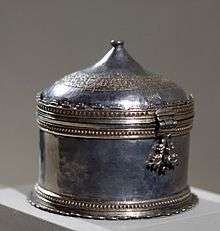Pyx
- Pyx is also the abbreviation for the constellation Pyxis.
A pyx or pix (Latin: pyxis, transliteration of Greek: πυξίς, boxwood receptacle, from πύξος, box tree) is a small round container used in the Catholic, Old Catholic and Anglican Churches to carry the consecrated host (Eucharist), to the sick or those otherwise unable to come to a church in order to receive Holy Communion. The term can also be used in archaeology and art history to describe small round lidded boxes designed for any purpose from antiquity or the Middle Ages, such as those used to hold coins for the Trial of the Pyx in England.
Usage

The word "pyx" comes from the Greek word πυξίς, "pyxis" meaning box or receptacle. The plural is pyxides. While the word may be applied to any covered carrier, in the modern usage the term is usually applied to small, flat, clamshell-style containers often about the size of a pocket watch and usually made of brass or other metals, traditionally lined with gold. A fabric or leather pouch in which the pyx may be carried is known as a burse. Typically, this kind of burse can be securely closed and is fixed with cords so that the priest, deacon, or extraordinary minister of Holy Communion can affix it to his or her person during transport to prevent the consecrated host(s) from being accidentally lost.
The term pyx is also a standard term used in the Catholic Church to refer to a flat, circular container, sometimes called a lunette, composed of a ring of metal (usually lined with gold) holding two glass or crystal disks, to create a round, flat, glass-enclosed space for the Eucharistic Host. This is used together with a monstrance for exposition and Benediction services. The lunette is often kept in another object, itself sometimes called a pyx, luna, or custodia, which is usually a round box often on a small stand, giving the impression of a faceless, old-fashioned, alarm clock.
All of these objects, whenever they contain a consecrated host, are normally kept within the church tabernacle when they are not being carried. The tabernacle may be behind the main altar, at a side altar, or within a special Eucharistic chapel.
Liturgical history

In late antiquity, the custom developed in the East of suspending a vessel in the form of a dove (Greek: peristerion, Latin: peristerium) over the altar, which was used as a repository for the Blessed Sacrament. This custom is mentioned by Gregory of Tours in his Life of Saint Basil, and in several ancient French documents. The custom probably came to France from the East, for it never seems to have existed in Italy.[1] Examples of this practice may still be found in use today; for instance, in the Cathedral of the Dormition in Moscow.
Eastern Christian
In the Eastern Orthodox and Greek Catholic Churches, the pyx is the small "church tabernacle" which holds the Lamb (Host) that is reserved for the Liturgy of the Presanctified Gifts during Great Lent. This pyx may be either kept on the Holy Table (altar) or on the Prothesis (Table of Oblation) on the north side of the sanctuary.
See also
Notes and references
- ↑ Catholic History (March 1997), "Dove. Symbol of the Holy Ghost", The Seraph, XVII No. 7, retrieved 2007-08-01
External links
- Pyx article from Catholic Encyclopedia